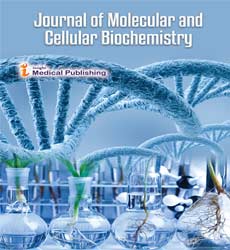Mechanism of Protein Degradation
Mohamed Rashed*
Department of Biochemistry, King Saud University Medical City, Riyadh, Saudi Arabia
- *Corresponding Author:
- Mohamed Rashed
Department of Biochemistry,
King Saud University Medical City,
Riyadh,
Saudi Arabia
E-mail: Rashedm@au.edu.sa
Received Date: November 04, 2021; Accepted Date: November 18, 2021; Published Date: November 25, 2021
Citation: Rashed M (2021) Mechanism of Protein Degradation. J Mol Cell Biochem Vol.5 No.5:009
Description
Proteasome degradation pathways regulate a wide range of protein functions by influencing not just their turnover but also the cell's physiological behaviour. This makes it a tempting target for infections, particularly viruses that rely on the host's cellular machinery to propagate and cause disease. Viruses have evolved a number of ways for manipulating the host proteasome machinery in order to create a cellular environment that is advantageous for their own survival and replication. Proteasome machinery, as a fundamental intracellular phenomenon, is known to affect nearly all cellular functions, including signaling pathways, chromatin structure, endocytosis, apoptosis, neuronal function, development, and immunology. The proteasome is the main component of this mechanism, which uses proteases to carry out proteolysis. Proteasomes can be found in the cell's nucleus and cytoplasm. The following are the two processes for protein breakdown by proteasomes:
• Ubiquitin-Dependent Proteasomal Degradation Pathway
• Lysosomal Proteolysis
Ubiquitin-dependent proteasomal degradation pathway
The Ubiquitin-Dependent Proteasomal Degradation Pathway (UPP) is made up of coordinated enzyme operations that attach chains of the polypeptide co-factor Ub to proteins in order to designate them for destruction. The 26S proteasome, a huge multicatalytic protease complex that degrades ubiquitinated proteins to tiny peptides, recognizes them as a result of this tagging process. To attach Ub chains onto proteins that are destined for destruction, three enzyme components are required. The E1 or Ub-activating enzyme and E2s (Ub-carrier or conjugating proteins) enzymes prepare Ub for conjugation, but the E3 (Ub-protein ligase), which identifies a specific protein substrate and catalyses the transfer of activated Ub to it, is the main enzyme in the process. One ATP molecule is hydrolysed at this phase. Ubiquitin is then transported to E2's active site in the next step of ubiquitin conjugating enzyme. E3 or ubiquitin ligase enzyme) identifies the degraded substrate protein and catalyses the transfer of ubiquitin molecule from E2 to the substrate in the third stage. Polyubiquitin chains are formed when these three stages are repeated many times.
Lysosomal proteolysis
Protein absorption by lysosomes is the other major mechanism of protein breakdown in eukaryotic cells. Lysosomes are organelles with a membrane that contain a variety of digesting enzymes, including multiple proteases. They play a variety of roles in cell metabolism, including endocytosismediated digestion of external proteins and the slow turnover of cytoplasmic organelles and cytosolic proteins. Proteases and other digestive enzymes are contained within lysosomes, preventing uncontrolled disintegration of the cell's contents. As a result, cellular proteins must first be taken up by lysosomes before being degraded by Lysosomal proteolysis. The production of vesicles (autophagosomes) in which small regions of cytoplasm or cytoplasmic organelles are contained in membranes produced from the endoplasmic reticulum is one method for cellular protein uptake. The contents of these vesicles are then digested by the degradative Lysosomal enzymes once they merge with lysosomes. Because protein uptake into autophagosomes appears to be nonselective, longlived cytoplasmic proteins are eventually degraded slowly. This review provides a thorough overview of the biology of with a focus on the proteasomal machinery. Since ubiquitination and deubiquitination have been identified as possible pathogenic players.
Open Access Journals
- Aquaculture & Veterinary Science
- Chemistry & Chemical Sciences
- Clinical Sciences
- Engineering
- General Science
- Genetics & Molecular Biology
- Health Care & Nursing
- Immunology & Microbiology
- Materials Science
- Mathematics & Physics
- Medical Sciences
- Neurology & Psychiatry
- Oncology & Cancer Science
- Pharmaceutical Sciences
